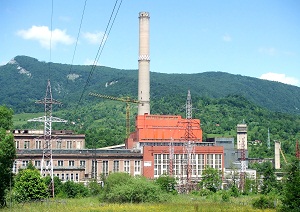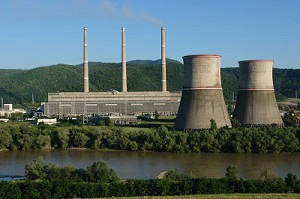|
|
||||

|
||||
About Us
Mintia Thermal Power Plant has been designed as a regulation power plant in the National Power System, and Paroșeni Thermal Power Plant - as a restart power plant for the power system in Romania, so they have been thought out to operate as strategic points in the National Power System. Their merging in one economic entity - Complexul Energetic Hunedoara - makes Hunedoara County an important player on the regional energy market.
Electrocentrale Deva
Deva Thermal Power Plant is located in the South-Western part of Transylvania on the Mures River at a distance of 9 km from town of Deva. The plant has an installed power of 1285 MW, consisting in four power units of 210 MW each, plus one unit of 235 MW supplied by steam boilers of 660 t/h, 13,72 MPa, 550 °C, each unit is independent. Four of them are endowed so that they can cogenerate in a 210/160MW system for delivering steam through adjustable 1,2; 2,5 and 6 bar intakes. The extracted steam is used in the heat exchangers for preparing the heat carrier in the main network, having an adjusting diagram with peak temperatures of 150/70 °C.
The building of the plant had been justified mainly by the necessity of supplying electricity in a high industrialized area, taking into consideration the possibility of being fed with fuel from the Valea Jiului coal field. When this location was chosen, it had been taken into account the advantage of using the conditions provided by Mures River - the accomplishment of a cooling water open network and the connection of the plant to the railway and national road Arad - Deva.
The construction works started in 1966 and the commissioning of the plant had been performed in three stages:
Each unit is endowed with 330t/h steam boilers operating on hard coal firing. The rated hourly consumption per unit and the resulted slag quantity may vary between 25 - 35%. The power is delivered into the National Power System through an interconnection station - Mintia - of 110kV, 220 kV and 400 kV. The power plant was commissioned in three stages:
Unit no. 3 was rehabilitated in 2009 up to 235 MW. Unit no. 1 was withdrawn from operation in 2012. District Heating DevaThe District Heating Department within Complexul Energetic Hunedoara supplies primary heating power for 52 urban heating plants, 35 of them belong to C.E.H., and are completely rehabilitated, and the others belong to some economic operators under contract with the company. For acquiring the thermal power at the installed power, the urban heating plants are endowed with heat exchangers with high efficiency pumping panels and units. The secondary network that provides heating distribution (heat carrier with an adjusting diagram at the consume peak of 95/75 °C and waste hot water with a maximum temperature of 60 °C) from the urban heating plants to the consumers, supplies the apartments mainly situated in buildings of 3 to 10 floors.
At the end of 2012 the heating services and waste hot water consumers were:
After '90s many people chose to have apartment gas heating systems, but the gas price increase and the thermal networks rehabilitation convinced them to turn back to the urban heating system. At the District Heating Department are many requests coming from Owners Associations in Deva, for connecting to the urban heating system and installation of individual metering devices. Paroșeni Thermal Power Plant
The development of Jiu Valley, in all respects, has been closely linked to the exploitation of coal fields. The first exploitation works of coal
 fields from Jiu Valley were performed in 1848 by brothers Hoffman and by Carol Madersbach, mine owners in Rusca Montană, attracted by the discovery of coal in the valleys of rivers. fields from Jiu Valley were performed in 1848 by brothers Hoffman and by Carol Madersbach, mine owners in Rusca Montană, attracted by the discovery of coal in the valleys of rivers.
At the beginning of 1867, the works for Simeria-Petrosani railway started, achieving through this a modern means of transportation, as the railway engine started to use coal from Jiu Valley. Consequently, it started the boring of side galleries in Petroşani-Est and Petrila mines.
During this period, coal exploitation works were performed at Lupeni, Vulcan and Aninoasa by various companies.
In the years during the Second World War, coal production increased every year, reaching a peak in 1943 of 2.755.880 tons. In 1943, Vulcan power generating station is equipped with a new turbo generator of 13.3 MW.
The power requested by developing mine exploitations and coal preparing plants, increased in 1955 to 50 MW, and in 1960 to approx. 55 MW. Building a hydroelectric plant in a short time in this region was not possible; therefore it remained the solution of a coal power plant, especially since in the region there have been large coal supplies. The settlement of Paroseni power plant was chosen “at the bank”, and by connecting the 220kV overhead power line with Targu-Jiu station, it was envisaged the interconnection between Oltenia and South-West Ardeal power systems.
The first power unit of 150MW in the country and the largest one at that time, Paroseni TPP was the first Romanian power plant, with an installed power of 300MW.
According to „National Strategy of Development”, to the governmental programmes as well as to the “Romanian energy roadmap”, Paroseni TPP was included into the rehabilitation and development programme for power unit 4 of 150 MW, with external financing, its transformation from condensation unit into cogeneration power unit as well as the decommissioning, inventory and improvement of the 3 x 50 MW stage;
|
Login |
|||


